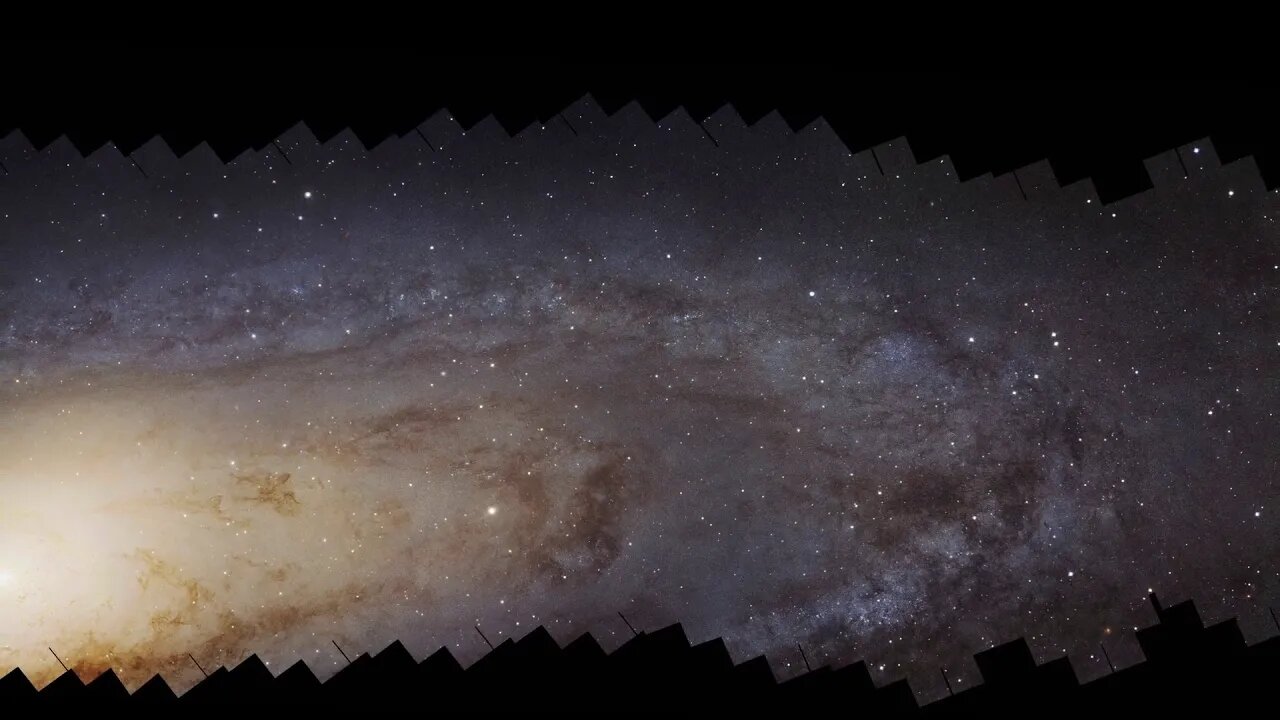Premium Only Content

🔴👀🔴 Simulated Image Shows the Power of NASA’s WFIRST
NASA’s Wide Field Infrared Survey Telescope, WFIRST, will capture the equivalent of 100 high-resolution Hubble images in a single shot, imaging large areas of the sky 1,000 times faster than Hubble. In several months, WFIRST could survey as much of the sky in near-infrared light—in just as much detail—as Hubble has over its entire three decades.
Although WFIRST has not yet opened its wide, keen eyes on the universe, astronomers are already running simulations to demonstrate what it will be able to see and plan their observations.
This simulated image of a portion of our neighboring galaxy Andromeda (M31) provides a preview of the vast expanse and fine detail that can be covered with just a single pointing of WFIRST. Using information gleaned from hundreds of Hubble observations, the simulated image covers a swath roughly 34,000 light-years across, showcasing the red and infrared light of more than 50 million individual stars detectable with WFIRST.
While it may appear to be a somewhat haphazard arrangement of 18 separate images, the simulation actually represents a single shot. Eighteen square detectors, 16-megapixels each, make up WFIRST’s Wide Field Instrument (WFI) and give the telescope its unique window into space.
With each pointing, WFIRST will cover an area roughly 1⅓ times that of the full Moon. By comparison, each individual infrared Hubble image covers an area less than 1% of the full Moon.
WFIRST is designed to collect the big data needed to tackle essential questions across a wide range of topics, including dark energy, exoplanets, and general astrophysics spanning from our solar system to the most distant galaxies in the observable universe. Over its 5-year planned lifetime, WFIRST is expected to amass more than 20 petabytes of information on thousands of planets, billions of stars, millions of galaxies, and the fundamental forces that govern the cosmos.
For astronomers like Ben Williams of the University of Washington in Seattle, who generated the simulated data set for this image, WFIRST will provide a valuable opportunity to understand large nearby objects like Andromeda, which are otherwise extremely time-consuming to image because they are so big on the sky.
WFIRST could survey Andromeda nearly 1,500 times faster than Hubble, building a panorama of the main disk of the galaxy in just a few hours.
Read more: https://hubblesite.org/contents/news-...
Music credit: "Flight Impressions" from Universal Production Music
Credits: NASA's Goddard Space Flight Center
Scott Wiessinger (USRA): Lead Producer
Ben Williams (U. Washington, Seattle): Visualizer
Scott Wiessinger (USRA): Narrator
This video is public domain and along with other supporting visualizations can be downloaded from NASA Goddard's Scientific Visualization Studio at: https://svs.gsfc.nasa.gov/13497
If you liked this video, subscribe to the NASA Goddard YouTube channel: http://www.youtube.com/NASAExplorer
Follow NASA’s Goddard Space Flight Center
· Instagram http://www.instagram.com/nasagoddard
· Twitter http://twitter.com/NASAGoddard
· Twitter http://twitter.com/NASAGoddardPix
· Facebook: http://www.facebook.com/NASA.GSFC
· Flickr http://www.flickr.com/photos/gsfc
Wide Field Infrared Survey Telescope...
Subscribe to my entertainment channel too for original videos!
https://www.youtube.com/channel/UCiNFsoytAuun90UzU5AuxXg
My Bitchute channel
https://www.bitchute.com/channel/YsJ0PYUWx5An/
My Patreon page https://www.patreon.com/user?u=26453564
-
 5:16
5:16
Kurt's News
23 days agoJim Jordan GRILLS FEMA Chief After Workers SKIP Pro-Trump Homes
56 -
 14:04
14:04
Forrest Galante
9 hours agoHow I Was Almost Sentenced to Death in Asia (True Story)
29.6K5 -
 5:55
5:55
BIG NEM
12 hours agoThe Simple Secret to Unlocking Your Creativity
15.2K -
 1:00:09
1:00:09
PMG
2 days ago $10.88 earned"MAHA & What Should Be Next With Mark Sherwood"
22.1K1 -
 2:44
2:44
Memology 101
9 hours ago $4.98 earnedWhat a snake...
11.3K6 -
![🔴LIVE : THE FINALS Season5 [The World's STRONGEST Gamer] 1080p 60fps](https://1a-1791.com/video/s8/1/4/m/-/L/4m-Lv.0kob-small-LIVE-THE-FINALS-Season5-The.jpg) 2:14:36
2:14:36
PacPowerTV
8 hours ago🔴LIVE : THE FINALS Season5 [The World's STRONGEST Gamer] 1080p 60fps
70.3K10 -
 5:11:27
5:11:27
Joe Donuts Gaming
9 hours ago🟢Live : City Boy Inherits A Ranch 😧😓
57.2K5 -
 3:41:12
3:41:12
Fresh and Fit
14 hours agoDaniel Penny ACQUITTED & BLM Meltdown
109K29 -
 42:46
42:46
barstoolsports
12 hours agoThe Shred Line with Coach Gruden, Dave Portnoy and Steven Cheah | Week 15
74.4K5 -
 3:43:53
3:43:53
EricJohnPizzaArtist
9 hours agoAwesome Sauce PIZZA ART LIVE Ep. #27: Christmas Special! Dr. Disrespect is Coming to Town!
46.1K9